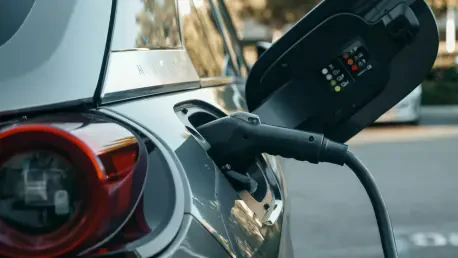The global landscape of transportation is undergoing a seismic shift toward sustainability, and at the heart of this transformation lies the Electric Vehicle (EV) Finance Market, a dynamic sector poised for unprecedented growth with a valuation of USD 55,026 million in 2024. This specialized financial arena is forecasted to expand at a staggering compound annual growth rate (CAGR) of 29.84% from 2025 to 2033. This remarkable trajectory is propelled by the accelerating adoption of electric vehicles worldwide, driven by mounting environmental concerns, robust government policies, and rapid technological advancements. EV financing, which includes tailored loans, leasing arrangements, and incentives, serves as a critical bridge, making these eco-friendly vehicles accessible to diverse consumer segments. From individual buyers seeking greener alternatives to businesses transitioning entire fleets, the role of financing cannot be overstated in facilitating this green revolution. As traditional combustion engine vehicles are increasingly sidelined in favor of zero-emission options, financial solutions are emerging as indispensable tools to address the often steep upfront costs of EVs. This article explores the key drivers, emerging trends, regional dynamics, and competitive forces shaping this fast-evolving market, shedding light on how financial mechanisms are fueling the global push toward sustainable mobility.
Forces Fueling Market Expansion
The surge in the EV finance market is deeply rooted in a collective global emphasis on environmental sustainability, with electric vehicles positioned as a cornerstone in the fight against climate change. Consumers are becoming more conscious of their carbon footprints, while policymakers are prioritizing initiatives to curb emissions through actionable measures. Governments across various regions are rolling out substantial subsidies, tax exemptions, and low-interest loan programs to incentivize EV purchases. These efforts directly bolster the finance market by alleviating the financial burden on potential buyers, making electric vehicles a viable option for a broader demographic. This alignment of consumer intent and policy support creates powerful momentum, positioning EV financing as a pivotal enabler in the transition to cleaner transportation alternatives.
Beyond environmental motivations, regulatory frameworks play a significant role in driving market growth. Many regions, particularly in Europe and parts of Asia, have implemented stringent emission standards and timelines for phasing out fossil fuel-dependent vehicles. Such mandates compel both individuals and corporations to pivot toward electric alternatives, thereby increasing demand for accessible financing solutions. Financial institutions are responding by crafting innovative products tailored to the unique needs of EV buyers, such as extended repayment terms or bundled insurance packages. This regulatory push not only accelerates EV adoption but also fosters a fertile ground for the finance sector to innovate and expand, ensuring that the market keeps pace with the evolving demands of sustainable mobility.
Evolving Market Segments and Trends
Diving into the structure of the EV finance market reveals insightful trends across its various segments, particularly when categorized by vehicle type. New vehicles currently hold the lion’s share, largely due to government incentives that are often exclusive to fresh purchases, coupled with the allure of the latest models featuring cutting-edge technology. These factors make new EVs an attractive proposition for buyers willing to invest in state-of-the-art solutions. However, as the market matures, the used vehicle segment is gaining significant ground. With early adopters trading in their EVs, a secondary market is emerging, offering more affordable options for cost-sensitive consumers. This trend broadens the accessibility of electric vehicles, ensuring that sustainability is not limited to those with higher budgets but extends to a wider audience through flexible financing.
Another lens through which to view the market is the source of financing, where traditional banks currently dominate due to their established reputation and structured lending frameworks. Their ability to cater to both individual buyers and commercial entities with reliable loan products solidifies their position. Yet, Original Equipment Manufacturers (OEMs) are rapidly closing the gap by offering direct financing options, often integrated with vehicle purchase packages and supported by partnerships with fintech companies. These initiatives streamline the buying process, making EV ownership more seamless and appealing. The rise of OEM-driven financing reflects a broader trend of diversification in the market, where multiple players are innovating to capture consumer interest and drive adoption rates higher through customized financial solutions.
Regional Powerhouses and Growth Frontiers
Geographically, the Asia-Pacific region stands as the undisputed leader in the EV finance market, underpinned by strong governmental support and soaring adoption rates in key countries like China and India. China, in particular, has built an advanced EV ecosystem, bolstered by extensive financial infrastructure and strategic collaborations between manufacturers and lending entities. This dominance is further enhanced by the proliferation of digital financing platforms that simplify access to credit, especially in underserved areas. The region’s proactive approach to subsidies and innovative schemes, such as battery leasing, ensures that EV financing remains a critical driver of adoption, cementing Asia-Pacific’s position at the forefront of this global shift toward sustainable transportation.
Looking ahead, Europe is expected to emerge as the leading region during the forecast period from 2025 to 2033, driven by aggressive environmental policies and ambitious carbon neutrality targets. Stringent emission regulations, coupled with substantial investments in charging infrastructure, are creating a conducive environment for EV finance market growth. North America, with significant contributions from the U.S. and Canada, is also a key player, fueled by growing consumer awareness and federal incentives that encourage electric vehicle purchases. Meanwhile, emerging economies in other parts of the world are beginning to contribute to the market’s expansion as EV adoption gradually spreads. This global tapestry of regional dynamics illustrates how localized policies and cultural shifts are collectively shaping the trajectory of EV financing on an international scale.
Innovations Transforming Financing Models
Innovation is a defining feature of the EV finance market, with Non-Banking Financial Companies (NBFCs) and fintech firms introducing groundbreaking approaches to broaden access. NBFCs are making significant inroads by targeting rural and underserved populations, offering flexible loan terms that traditional banks often cannot match. This outreach is crucial for expanding EV adoption beyond urban centers, ensuring that sustainability reaches diverse communities. Meanwhile, fintech companies are revolutionizing the sector with digital platforms that leverage artificial intelligence for credit assessments, drastically reducing processing times and enhancing customer experiences. These technological advancements are making financing more inclusive and efficient, addressing barriers that have historically limited EV ownership.
Another transformative trend is the adoption of cost-reducing mechanisms like battery leasing, which tackles one of the most significant hurdles in EV purchasing—the high cost of batteries. By allowing consumers to lease rather than buy batteries outright, upfront expenses are significantly lowered, making electric vehicles more affordable. This model is gaining traction in markets like China and India, often through partnerships between OEMs and financial institutions. Such innovations not only democratize access to EVs but also encourage continuous upgrades as newer battery technologies become available. The focus on affordability and flexibility through these emerging models underscores the market’s adaptability, ensuring it meets the evolving needs of a diverse consumer base while supporting the broader goals of environmental sustainability.
Competitive Strategies and Market Challenges
The EV finance market is characterized by intense competition, with a mix of traditional financial institutions, OEMs, and agile startups vying for dominance. Major players are employing strategies such as partnerships, mergers, and geographic expansions to strengthen their foothold. These strategic moves often involve collaborations that integrate financing with vehicle sales, creating seamless experiences for consumers. Additionally, significant investments in fleet electrification highlight the market’s focus on commercial applications, where bulk EV purchases are supported by tailored financial packages. This competitive landscape reflects a market in constant flux, where adaptability and innovation are key to capturing and retaining market share amidst rapid growth.
Despite the promising outlook, the market faces notable challenges that could temper its expansion if left unaddressed. The high initial cost of EVs remains a significant barrier, even with financing options, as it deters potential buyers who compare them to cheaper conventional vehicles. Furthermore, the uneven distribution of charging infrastructure in many regions poses a practical obstacle, indirectly impacting financing demand by reducing consumer confidence. Financial institutions also grapple with risks tied to credit evaluation in emerging markets, where consumer credit histories may not be well-documented. Overcoming these hurdles requires coordinated efforts among governments, manufacturers, and financiers to enhance infrastructure, achieve cost reductions through scale, and develop robust risk management frameworks to sustain market momentum.
Shaping the Future of Sustainable Mobility
Reflecting on the journey of the EV finance market, it’s evident that this sector has become a linchpin in the global transition to sustainable transportation by addressing the financial challenges of EV adoption. Valued at USD 55,026 million in 2024, the market has demonstrated resilience and adaptability, achieving a projected CAGR of 29.84% through 2033. Environmental imperatives, regulatory mandates, and technological innovations stand as the bedrock of this growth, while trends like digital financing and battery leasing redefine accessibility. Challenges such as high costs and infrastructure gaps are acknowledged, yet the competitive strategies of key players showcase a commitment to overcoming these barriers. Regionally, Asia-Pacific’s early dominance paved the way, while Europe’s rise signals a future of even greater focus on green mobility.
Looking ahead, stakeholders must prioritize collaborative initiatives to build comprehensive charging networks and further reduce EV costs through economies of scale. Governments should continue to refine policies that incentivize adoption, while financial institutions explore innovative models to reach untapped markets. The integration of advanced technologies in credit assessment and customer engagement will be crucial for maintaining growth. As the world intensifies its efforts to combat climate change, the EV finance market stands ready to play an even larger role, offering scalable solutions that empower consumers and businesses alike to embrace a cleaner, more sustainable future in transportation.









